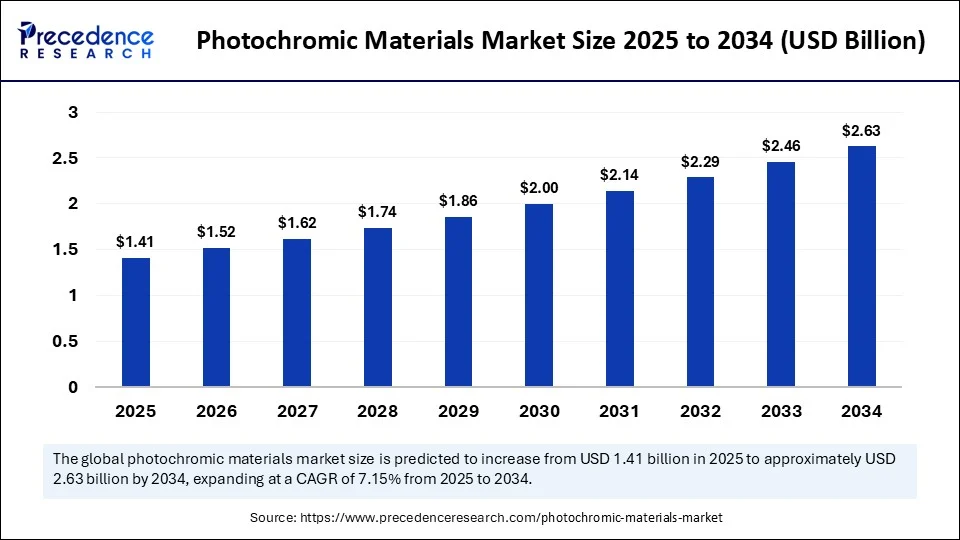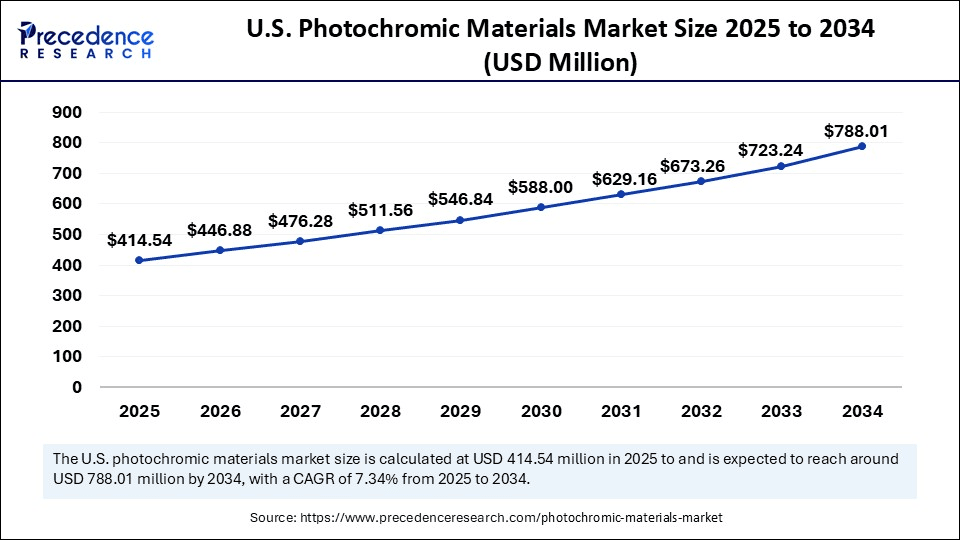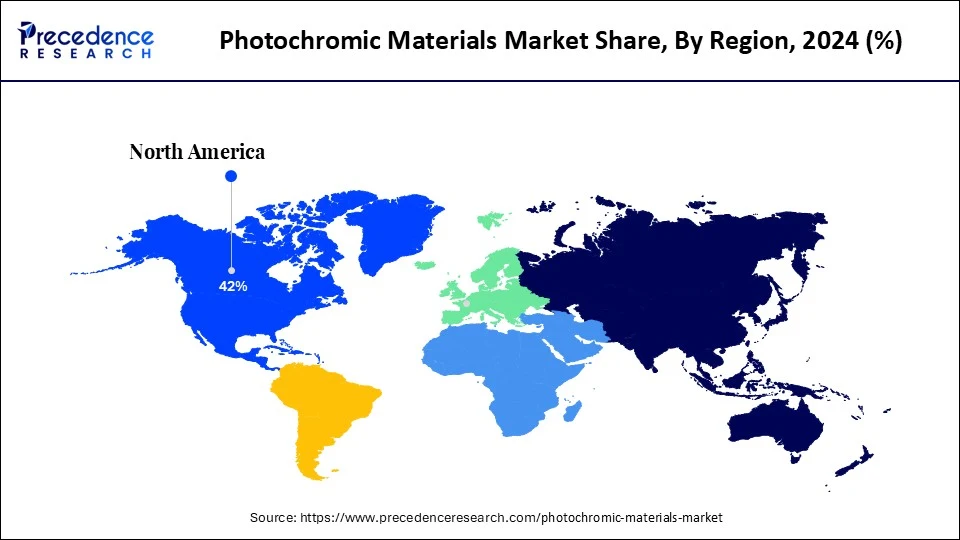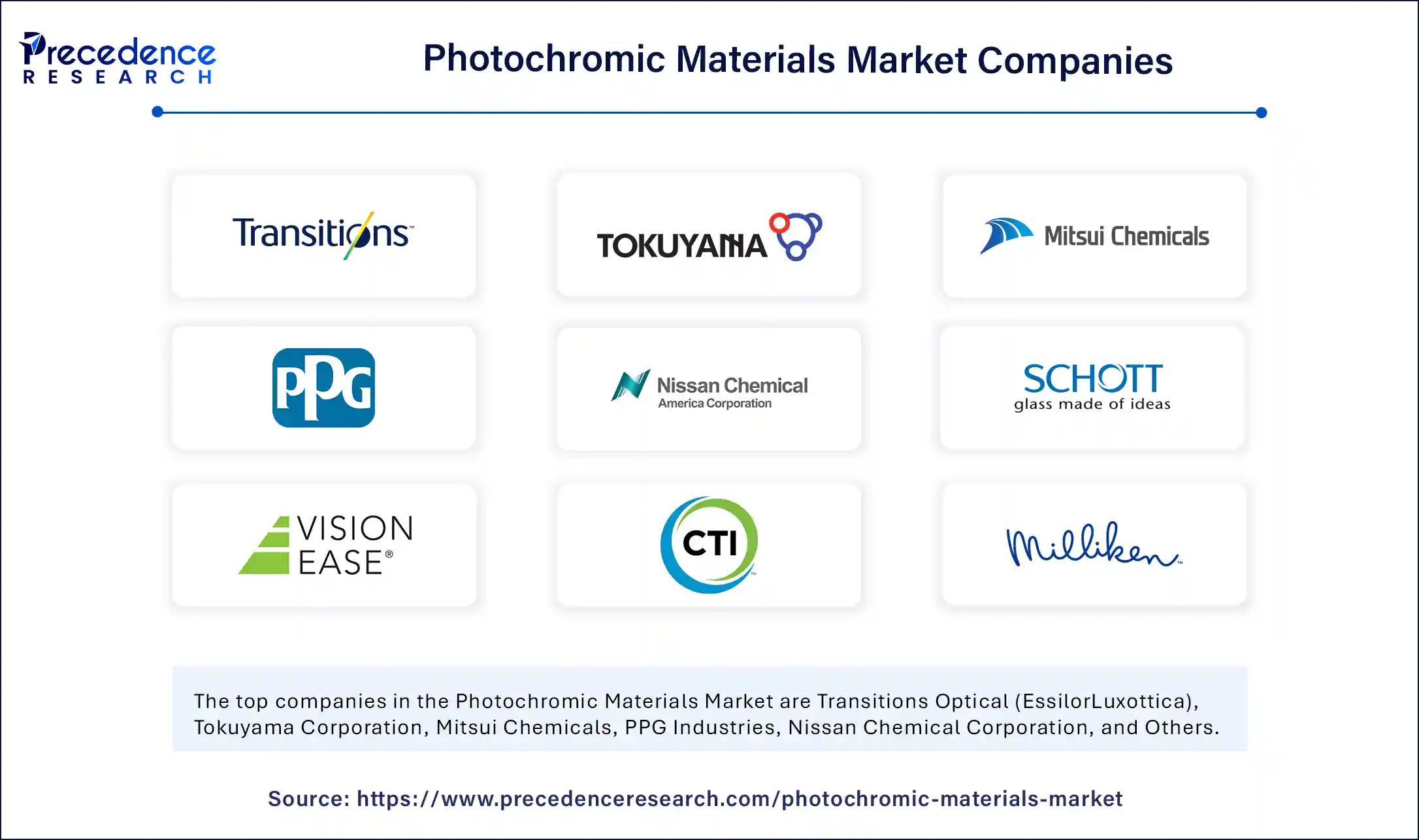Photochromic Materials Market Size and Forecast 2025 to 2034
The global photochromic materials market size accounted for USD 1.32 billion in 2024 and is predicted to increase from USD 1.41 billion in 2025 to approximately USD 2.63 billion by 2034, expanding at a CAGR of 7.15% from 2025 to 2034. The market is experiencing substantial growth due to the rising scope of applications in eyewear, textiles, and healthcare. The increasing preference for energy-efficient and multifunctional materials, along with a greater demand for innovative and adaptable solutions, is anticipated to drive market growth in the coming years.

Photochromic Materials MarketKey Takeaways
- In terms of revenue, the global photochromic materials market was valued at USD 1.32 billion in 2024.
- It is projected to reach USD 2.63 billion by 2034.
- The market is expected to grow at a CAGR of 7.15% from 2025 to 2034.
- North America dominated the photochromic materials market with the largest share of 42% in 2024.
- Asia Pacific is expected to grow at a significant CAGR from 2025 to 2034.
- By type of material, the inorganic photochromic materials segment held the major market share of 63% in 2024.
- By type of material, the organic photochromic materials segment is projected to grow at the highest CAGR between 2025 and 2034.
- By application, the eyewear segment captured the biggest market share of 74% in 2024.
- By application, the smart windows and films segment is expected to grow at a significant CAGR over the projected period.
- By end user, the consumer segment contributed the largest market share of 71% in 2024.
- By end user, the construction and architecture segment is expected to grow at a significant CAGR from 2025 to 2034.
- By activation mechanism, the UV-activated segment generated the major market share of 81% in 2024.
- By activation mechanism, the dual light-activated (UV + visible) segment is expected to expand at a significant CAGR from 2025 to 2034.
How is AI Influencing the Photochromic Materials Market?
Artificial intelligence (AI) is transforming the photochromic materials market by improving material design, streamlining product development cycles, and creating personalized experiences. AI algorithms can predict how materials will perform under various conditions, optimizing their properties and speeding up research. AI also helps identify new photochromic molecules with desired features, potentially leading to breakthroughs and new applications. Additionally, AI is enabling the creation of smart, interactive products like color-changing packaging and adaptive coatings, enhancing user experience and expanding industry use.
U.S. Photochromic Materials Market Size and Growth 2025 to 2034
The U.S. photochromic materials market size was exhibited at USD 388.08 million in 2024 and is projected to be worth around USD 788.01 million by 2034, growing at a CAGR of 7.34% from 2025 to 2034.

How Does North America Dominate the Photochromic Materials Market in 2024?
North America dominated the global market for photochromic materials with the largest share of 42% in 2024. This is due to the high adoption rate of these materials, particularly in automotive and eyewear applications. The region has a large geriatric population, who are more susceptible to vision problems and other eye-related conditions, boosting the need for photochromic lenses. North America's strong healthcare system, including access to specialized eye care, helps in the adoption of photochromic lenses and other advanced vision correction solutions. Additionally, advances in material technology, especially in smart building materials, and increasing awareness of UV protection further drive market growth in the region. Moreover, growing awareness about the harmful effects of UV radiation on the eyes and skin has increased demand for photochromic materials, especially in eyewear, to protect against UVA and UVB rays.
U.S. Photochromic Materials Market Trends
The U.S. plays a dominant role in the global market, especially in developing and applying photochromic lenses and smart windows. The country has a strong manufacturing base for these materials, particularly in the eyewear industry, with companies like Transitions Optical leading the way. The U.S. also leads in developing advanced photochromic technologies, including new materials, coatings, and lens designs, which improve performance and functionality. As a result, the U.S. remains a leader in innovation, research, and manufacturing, shaping the market.

What Makes Asia Pacific the Fastest-Growing Region in the Photochromic Materials Market?
Asia Pacific is expected to witness the fastest growth in the coming years. This is due to rapid industrialization, increasing construction activities, and rising consumer demand for advanced materials, which creates a greater need for photochromic applications, such as smart windows and specialized coatings. High population densities in countries like China and India contribute to a large customer base for products with photochromic features, such as lenses. Ongoing progress in material science is leading to more efficient and affordable photochromic products, further expanding the market. Governments across the region are actively promoting smart manufacturing, digital infrastructure, and the adoption of advanced technologies, which indirectly increases demand for photochromic materials. The rising adoption of eyewear further supports market growth within the region.
China Photochromic Materials Market Trends
China is a major player in the market within Asia Pacific. China is frontier in producing photochromic lenses and photochromic materials for various industries. The country is at the forefront of developing specialty materials, especially for electronics and automotive applications. China's expanding automotive and construction sectors, increasing disposable incomes, and growing demand for smart eyewear and functional consumer goods are driving market growth.
India Photochromic Materials Market Trends
India is emerging as a major player in the market, mainly due to its large and growing population, rising disposable incomes, and increasing awareness about eye care. The market growth is further fostered by demand for photochromic materials in eyewear, smart windows, and other areas. India's strategic location and economic growth position it as a potential hub for photochromic materials. With the growing prevalence of eye-related issues, there are high adoption rates of sunglasses, creating the need for photochromic materials.
What Factors Contribute to Photochromic Materials Market Within Europe?
Europe is expected to experience steady growth, driven by strong automotive and healthcare sectors and a focus on sustainability. Countries like Germany, France, and the UK lead in research and innovation in photochromic materials, especially for self-tinting windows and smart glass applications. The healthcare industry also sees high demand for photochromic lenses. European policies and initiatives promoting sustainability, such as the European Green Deal, are accelerating the adoption of eco-friendly materials, including photochromic compounds.
What Opportunities Exist in the Latin America Photochromic Materials Market?
Latin America is witnessing notable growth, particularly in countries like Brazil and Mexico. This growth is driven by increasing awareness of eye health and the adoption of advanced vision correction solutions. The energy, automotive, and construction sectors are also adopting photochromic materials to meet the demand for advanced technologies and energy-efficient solutions. Furthermore, governments in Latin America have recognized the importance of healthcare and are investing in solutions that promote eye health and the use of advanced technologies.
What are the Major Factors Boosting the Growth of the Photochromic Materials Market Within the Middle East and Africa?
In the Middle East and Africa, the market is expanding rapidly. Developing economies in this region, such as South Africa, Nigeria, and the UAE, are experiencing rising disposable incomes, leading to increased demand for premium eyewear products like photochromic lenses. Growing awareness about eye protection and the benefits of photochromic lenses in reducing glare and harmful UV rays is further contributing to market expansion. The region's hot climate and focus on energy-efficient solutions are driving the adoption of photochromic materials in various applications, such as automotive and architectural glass.
Market Overview
Photochromic materials are substances that reversibly change color or opacity when exposed to ultraviolet (UV) light or sunlight, returning to their original state when the light source is removed. These materials are used in ophthalmic lenses, smart windows, textiles, cosmetics, and security printing. This market includes the production and sale of these materials, which find applications across various industries such as eyewear, automotive, and textiles. The market is growing due to technological advances, rising demand for smart products, and increasing awareness of sustainability. The increasing demand for eyewear and smart windows is creating the need for photochromic materials, supporting market expansion.
What are the Key Trends in the Photochromic Materials Market?
- Rising Demand for Smart Products: Photochromic lenses in eyewear are gaining popularity due to their ability to adjust tint based on sunlight intensity, offering both convenience and UV protection. Further, the increasing demand for energy-efficient buildings is driving the adoption of smart windows that incorporate photochromic materials to regulate light and temperature.
- Increasing Consumer Preferences: Evolving consumer preferences for smart and sustainable products are driving the demand for photochromic materials. Also, Photochromic materials are also finding applications in medical diagnostics, drug delivery systems, and biocompatible materials, influencing global acceptance with demanding behavior and market penetration.
- Environmental Awareness and Sustainability Solutions: The enhanced emphasis on sustainability is encouraging the development and adoption of eco-friendly photochromic materials and production methods that contribute to energy savings by reducing reliance on artificial lighting and temperature control.
- Technological Advancements: Ongoing research and development in photochromic materials are resulting in the development of more durable, efficient, and higher-quality materials, including advancements in nanotechnology and materials science, enabling the development of novel photochromic materials with enhanced properties.
Market Scope
| Report Coverage | Details |
| Market Size by 2034 | USD 2.63 Billion |
| Market Size in 2025 | USD 1.41 Billion |
| Market Size in 2024 | USD 1.32 Billion |
| Market Growth Rate from 2025 to 2034 | CAGR of 7.15% |
| Dominating Region | North America |
| Fastest Growing Region | Asia Pacific |
| Base Year | 2024 |
| Forecast Period | 2025 to 2034 |
| Segments Covered | Type of Material, Application, End User, Activation Mechanism, and Region |
| Regions Covered | North America, Europe, Asia-Pacific, Latin America, and Middle East & Africa |
Market Dynamics
Drivers
Increasing Adoption of Photochromic Lenses
The primary driver of the photochromic materials market is the increasing adoption of photochromic lenses, fueled by consumer awareness and the need for eye protection against harmful UV radiation, as well as the growing popularity of photochromic lenses in eyewear. This is supported by the higher prevalence of eye disorders, digital eye strain, and conditions like diabetic retinopathy, which increase the need for corrective and protective eyewear, including photochromic lenses. Additionally, ongoing innovation in lens materials and manufacturing, such as faster transition times and better clarity indoors, enhances the appeal of these lenses. Consumers have become increasingly aware of the benefits of photochromic materials, including UV protection, which has led to a rise in demand.
Restraint
Limited Durability and High Costs
The major restraint in the photochromic materials market is the limited durability and high costs of these materials. Many organic photochromic materials degrade over time, as exposure to UV light and repeated cycling can weaken their ability to darken and lighten effectively. The initial research, development, and manufacturing of these materials can be costly, resulting in higher prices and limiting their wider adoption. Research must focus on developing more durable and stable organic materials or exploring alternatives, such as inorganic photochromic compounds, that can withstand a greater number of UV cycles. Moreover, the manufacturing process of photochromic materials is complex, which can lead to potential quality control issues and higher production costs.
Opportunity
Integrating Photochromic and Electrochromic Technologies
The key future opportunity in the photochromic materials market lies in integrating photochromic and electrochromic technologies to create multifunctional optical systems. This integration will enable the development of smart windows and facades with enhanced features and performance. Hybrid organic-inorganic systems and nanoencapsulation techniques improve the longevity and stability of photochromic coatings, making them suitable for long-term outdoor use in applications such as automotive windshields and building exteriors. Furthermore, healthcare researchers are exploring the application of photochromic materials in drug delivery systems, diagnostics, and medical imaging, opening up new growth avenues.
Type of Material Insights
How Did the Inorganic Photochromic Materials Segment Dominate the Photochromic Materials Market in 2024?
The inorganic photochromic materials segment dominated the market with a 63% share in 2024. This dominance is due to their superior durability, thermal stability, and resistance to harsh environmental conditions compared to organic materials. Inorganic substances like tungsten oxide (WO3) and molybdenum trioxide (MoO3) offer excellent thermal and chemical stability, making them ideal for long-term applications and widespread use. These qualities make them especially suitable for smart windows, optical memories, and durable decorative coatings, which also improve energy efficiency in buildings.
The organic photochromic materials segment is expected to grow at the fastest rate during the forecast period. The growth of the segment is attributed to organic photochromic materials' versatility, cost-effectiveness, and ability to tailor properties for different uses. These materials can be synthesized into various molecular structures, allowing for customization of features such as switching speed, color range, and durability to meet specific needs. They are easily integrated into polymer matrices, which is essential for applications such as ophthalmic lenses and smart windows. Ongoing research aims to enhance their stability, lifespan, and performance, thereby broadening their potential applications.
Application Insights
What Made Eyewear the Dominant Segment in the Photochromic Materials Market in 2024?
The eyewear segment dominated the market, holding the largest market share of 74% in 2024. This is mainly because of the benefits of photochromic lenses in providing both vision correction and sun protection in one pair of glasses. They offer a seamless transition in varying light conditions and are popular as fashion accessories, with a wide range of styles to suit preferences. This convenience, along with technological advances and increased awareness of UV protection, has driven considerable growth in the eyewear sector. Furthermore, innovations and advancements in photochromic technology, such as faster activation speeds, improved optical performance, and enhanced durability, have made these lenses more appealing to consumers.
The smart windows and films segment is expected to expand at the highest CAGR in the upcoming period. This is mainly due to their ability to improve energy efficiency and comfort in buildings. Photochromic smart windows and films can adjust their tint based on sunlight, controlling heat and light entry and reducing reliance on artificial lighting and HVAC systems. This leads to significant energy savings and lower electricity bills. The growth is supported by the rise of green building projects, increased energy conservation awareness, and technological innovations that create more comfortable and productive environments.
End User Insights
How Does the Consumer Segment Dominate the Photochromic Materials Market in 2024?
The consumer segment dominated the market with a 71% share in 2024. This dominance results from increased awareness of eye health among consumers and advances that improve the performance and appearance of photochromic materials. Consumers are increasingly preferring photochromic lenses, as these lenses automatically adjust to changing light, eliminating the need for separate sunglasses and offering convenience for daily use. The segment growth is also driven by the rising use of digital devices and the prevalence of vision-related conditions, boosting the demand for eyewear.
The construction and architecture segment is expected to grow at the fastest CAGR in the coming years. This is mainly due to the rising construction activities, along with the increasing demand for architectural glass. The ability of photochromic materials to offer energy-efficient and glare-reducing solutions makes them suitable construction materials. By intelligently managing light, photochromic materials minimize glare and enhance the comfort and usability of indoor spaces. Photochromic materials can be integrated into building facades and windows, offering architects and designers new ways to create dynamic and visually appealing structures. As the construction industry moves towards smart and sustainable buildings, photochromic materials are becoming increasingly important in meeting these demands with a cost-effective choice.
Activation Mechanism Insights
What Made UV-Activated the Dominant Segment in the Photochromic Materials Market in 2024?
The UV-activated segment dominated the market, holding a 81% share in 2024, owing to its effectiveness in automatically darkening upon exposure to UV light. This technology is widely used in eyeglasses and sunglasses, providing a seamless transition between indoor and outdoor settings as a convenient solution for users. Research and development efforts are focused on improving the performance characteristics of UV-activated photochromic materials, including faster switching speeds, increased durability, enhanced sensitivity, and new chemical compounds and material combinations to create more efficient and versatile products.
In March 2024, a study published in the Journal of Materials Today Communications focused on photochromic polymer capsules as smart materials, with research showing good photostability and the ability to withstand multiple UV exposure cycles. These capsules are being explored for uses like smart fabrics and coatings, offering the potential for controlled drug release and other stimuli-responsive systems.
(Source: https://www.sciencedirect.com)
The dual light-activated (UV + visible) segment is expected to grow at the fastest rate during the forecast period. This is mainly because it offers improved performance and versatility in applications such as eyewear and smart windows. Dual-activated photochromic materials can adapt to a broader range of light, enabling faster transitions and better performance in different lighting conditions. These materials are increasingly used in eyewear, smart windows for buildings and vehicles, and emerging fields like photochromic recording media. For example, researchers have developed biodegradable and flexible MoO3/Sg-St NCs that can block UV light and have a quick photochromic response, making them suitable for smart window applications.
Photochromic Materials Market Companies

- Transitions Optical (EssilorLuxottica)
- Tokuyama Corporation
- Mitsui Chemicals
- PPG Industries
- Nissan Chemical Corporation
- Schott AG
- Vision Ease
- Color Change Corporation
- Chromatic Technologies Inc. (CTI)
- Milliken Chemical
Recent Developments
- In May 2024, LensCrafters, part of EssilorLuxottica, launched Transitions GEN S, which features the fastest grey lens in the clear-to-dark photochromic category. These ultra-responsive lenses are fully clear indoors and can darken in seconds outdoors. They are available in all LensCrafters stores in North America and on LensCrafters.com, providing a high-quality eye care experience and vision solutions tailored to meet lifestyle needs.
(Source: https://www.prnewswire.com) - In April 2024, Indizen Optical Technologies of America (IOT America) announced the addition of Neochromes FT-28 flat-top polycarbonate photochromic lenses to its latest generation of Neochromes products. This development showcases their commitment to innovation and excellence by offering significant advancements in the bifocal lens market. The new lenses provide unmatched photochromic performance with enhanced features.
(Source: https://www.opticaljournal.com) - In January 2024, PsiQuantum and Mitsubishi UFJ Financial Group announced a collaboration with Mitsubishi Chemical Group on a joint project to simulate excited states of photochromic molecules. This research holds significant potential for industrial and residential applications, including the development of smart windows, energy-efficient data storage, solar energy storage, solar cells, and other uses of photoswitching technology. This initiative paves the way for developing new, more powerful, energy-efficient photonic materials.
(Source: https://www.businesswire.com)
Segments Covered in the Report
By Type of Material
- Inorganic Photochromic Materials
- Silver halide-based
- Transition metal oxides (e.g., tungsten trioxide)
- Organic Photochromic Materials
- Spiropyrans
- Spirooxazines
- Diarylethenes
- Chromenes
- Hybrid/Composite Materials
- Nanocomposite films
- Polymer blends with organic photochromic dyes
- Nanocomposite films
By Application
- Eyewear
- Prescription photochromic lenses
- Sunglasses
- Smart Windows and Films
- Commercial buildings
- Automotive glazing
- Textiles & Apparel
- UV-activated fashion and functional garments
- Cosmetics
- UV-sensitive nail paints and skin products
- Security & Anti-counterfeiting
- Inks for secure documents
- Currency and ID verification
- Others
- Sensors
- Wearables
- Consumer novelty items
By End User
- Consumer (Eyewear, Fashion)
- Construction & Architecture
- Automotive
- Healthcare & Cosmetics
- Security & Printing
- Electronics
By Activation Mechanism
- UV-Activated
- Visible Light-Activated
- Dual Light-Activated (UV + Visible)
- Thermochromic & Photochromic Hybrid Materials
By Region
- North America
- Europe
- Asia-Pacific
- Latin America
- Middle East and Africa
For inquiries regarding discounts, bulk purchases, or customization requests, please contact us at sales@precedenceresearch.com
Frequently Asked Questions
Ask For Sample
No cookie-cutter, only authentic analysis – take the 1st step to become a Precedence Research client
 sales@precedenceresearch.com
sales@precedenceresearch.com
 +1 804-441-9344
+1 804-441-9344